
Lot 208

A fine Scottish George II bullet teapot AMENDMENT TO CATALOGUE
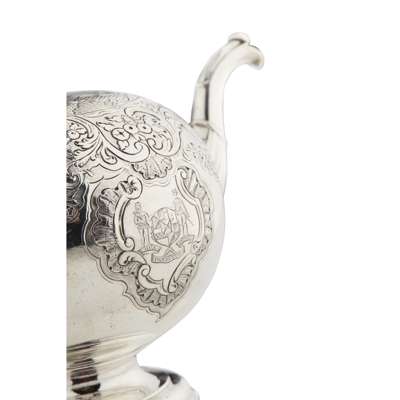
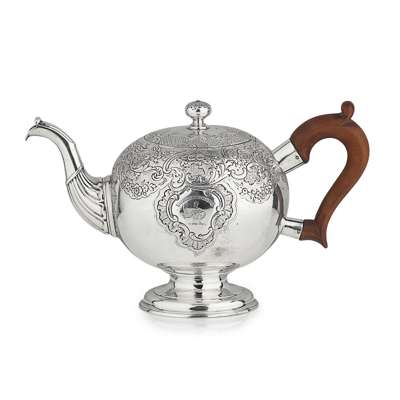
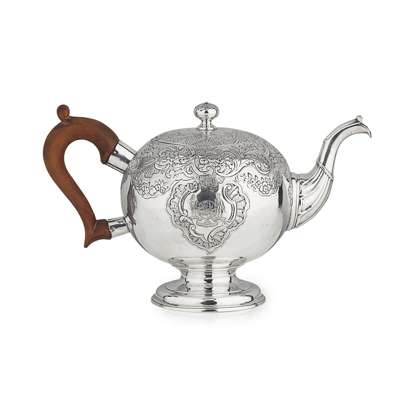
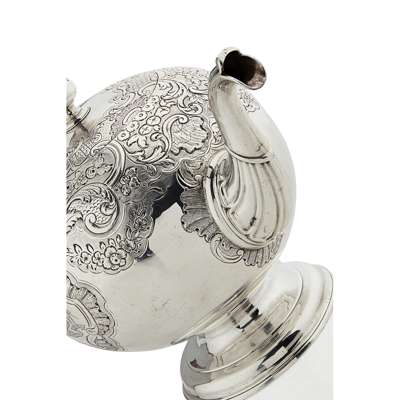


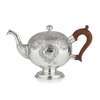


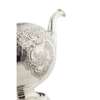
Auction: 12 October 2016 at 11:00 BST
Description
Charles Duncan, maker, Archibald Ure, assay master, Edinburgh 1737, of traditional form, well chased band to the body and the hinged cover, ball finial, the body with scroll cartouches, engraved crest, motto and armorial, curved spout, all raised on a stepped pedestal foot
Dimensions
Height: 14.5cm, weight (all in): 20oz
Footnote
The armorial bearings that are engraved upon this George II Scottish Silver Bullet Teapot hallmarked Edinburgh 1737, are those of Colonel Alexander Campbell of Finab (sometimes spelt Fonab/Finob) in the County of Perthshire. They may be blazoned as follows:
Arms: Quarterly 1st and 4th Gyronny of eight or and sable (for Campbell) 2nd Argent a lymphad her sails furled and oars in action all sable (for Lorn) and 3rd Or a fess chequy argent and azure (Stewart) en surtout Azure a saltire argent between a ship under sail flagged of Scotland in chief proper a Peruvian sheep in base a camel on the dexter and an elephant on the sinister all proper the first two of these loaded and the last bearing a turret of the second * (for The Company of Scotland trading to Africa and the Indies)
* These arms depicted en surtout were granted as an augmentation to Alexander Campbell of Finab for his actions against the Spanish at Toubacanti in Central America during second expedition in the year 1699 of the ill-fated Darien Venture that was supported by The Company of Scotland trading to Africa and the Indies.
Crest: A soldier in armour from the middle upwards brandishing a drawn sword in his right hand all proper and sustaining on his left arm a shield azure charged with a unicorn’s head couped argent horned and maned or **
** Here the engraver appears to have engraved in error ‘a unicorn couchant reguardant’ rather than a unicorn’s head as described in the blazon above.
Mottoes: (below the arms) Qua panditur orbis [To wherever the world extends]
(above the crest) Quid non pro patria [What would not one do for his country?]
Supporters: (Dexter) A naked Indian wreathed round the middle with linen holding in his dexter hand a bow bent with a quiver of arrows hanging at his back proper
(Sinister) A Spaniard in his proper habit proper
These armorial bearings are often blazoned having a compartment upon which the supporters stand in which is represented ‘the sun rising proper’. So saying, there is, perhaps, a token of this compartment shown rising out of the bottom motto scroll.
There is very little known about the early life of Colonel Alexander Campbell of Finab (born circa 1660’s). He was the grandson of Archibald Campbell of Lagvinshoch and Monzie in the County of Perthshire (died 1640) and it would appear that he married twice, firstly to Susan Menzies, daughter of Sir Alexander Menzies of Weem in the County of Perthshire whom he married sometime after 1693, and secondly to Mary Home at Blackadder in the County of Berwickshire on the 1st March 1717. It is stated that his marriage to Susan produced four children (three sons and a daughter), whilst his marriage to Mary produced no issue.
After his adventures during the second expedition of the Darien Venture where he took command at Toubacanti and he led his men in pre-emptive attack and managed to repel some 1600 Spaniards, after which a medal was struck back in Scotland (see below) to celebrate this short term victory. Shortly thereafter the Scottish colony of New Caledonia collapsed and many who took up the challenge died of disease and malnutrition, whilst a few colonists managed escape eventually to achieve landfall on Jamaica most never to see their homeland again. That being said, Alexander with a few companions did arrive back in Scotland. By all accounts, he never forgave the Company for its treachery towards the colonists who attempted to found Scotland’s own colony in Central America.
During his later military career, Alexander played a part in helping to suppress the first Jacobite rising of 1715. During that same year his portrait was painted by William Aikman (see below). He was closely involved with the raising of Independent Companies of Highlanders to police the Highlands during the lawless periods of the Jacobite troubles. Amongst these independent companies, one of which Alexander was to command was the predecessor of The Black Watch, which was formed in 1739. The portrait of Alexander as mentioned above is now displayed in the Regimental Museum of the Black Watch at Balhousie Castle in Perth.
(Left) Portrait of Alexander Campbell of Finab by William Aikman (Black Watch Museum).
(Right) The Armorial Bearings of the Company of Scotland trading in Africa and the Indies.
The Toubacanti Medal struck by the Company of Scotland trading in Africa and the Indies to commemorate Alexander Campbell of Finab’s victory against the Spanish in New Caledonia during the second expedition of the ill-fated Darien Venture.









